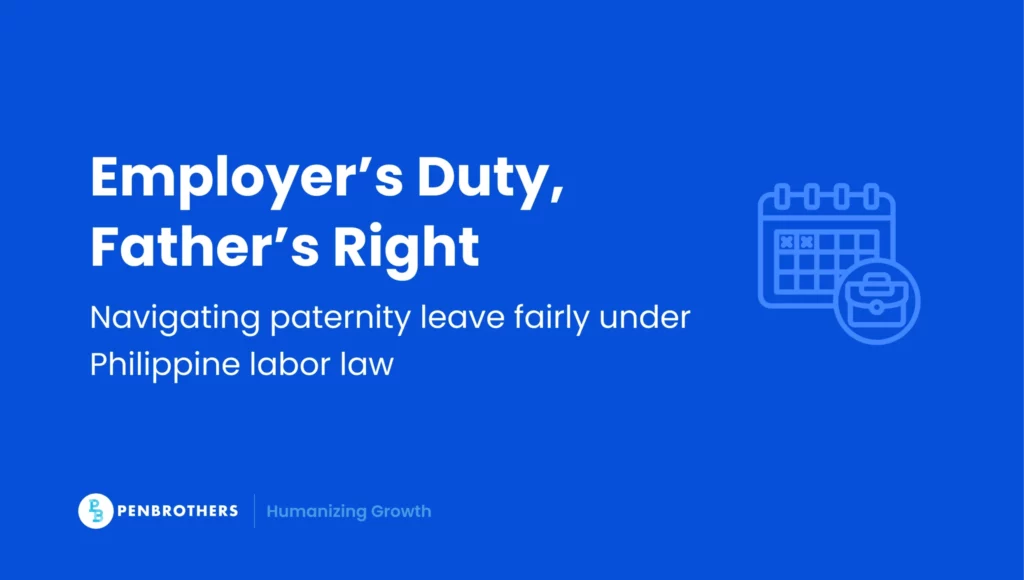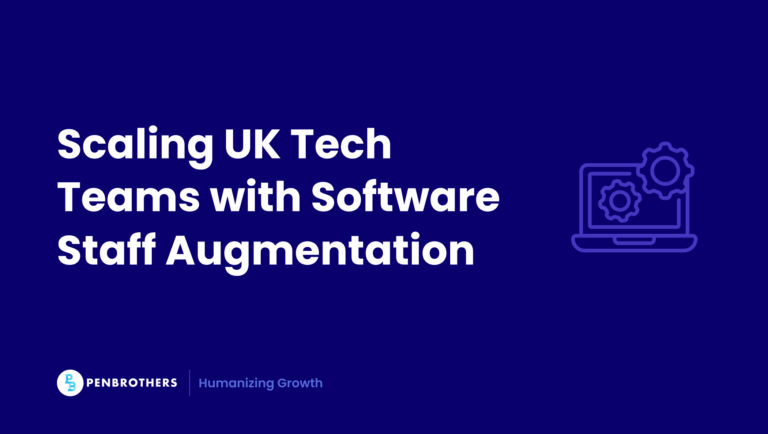Paternity leave isn’t just a statutory benefit. It’s a crucial step toward building more equitable families and healthier workplaces. When fathers are given time to support their partners and bond with their newborns, it improves family well-being and contributes to employee satisfaction and retention.
Under the Paternity Leave Act of 1996 (RA 8187) and the Expanded Maternity Leave Law (RA 11210), paternity leave is a legal right in the Philippines. This guide covers everything both employees and employers need to know: eligibility, the step-by-step application process, employer obligations, and FAQs.
Key Takeaways
- Two Separate Laws Govern Paternity Leave: It is crucial to understand there are two paths to leave. The Paternity Leave Act (RA 8187) grants 7 paid days but is strictly for legally married fathers. Separately, the Expanded Maternity Leave Law (RA 11210) allows a mother to transfer up to 7 days of her leave to the child’s father, regardless of marital status.
- Funding Depends on the Type of Leave: The standard 7 days of paternity leave for married employees are fully paid by the employer, with no reimbursement from the SSS. However, for the additional 7 days that are transferred from the mother, the employer advances the payment but can and should claim reimbursement from the SSS.
- Leave is 7 to 14 Days and Flexible: A qualified father is entitled to a base of 7 paid days. This can be extended to 14 days if the mother agrees to transfer 7 days of her maternity leave. This leave can be used flexibly, either consecutively or split up, within 60 days of the child’s birth.
- Proactive Notification is Required: Paternity leave is not automatic. The employee must formally apply by notifying their employer in advance (ideally upon pregnancy confirmation), submitting the required company leave form, and providing necessary documents like the marriage certificate and, later, the child’s birth certificate.
What Is Paternity Leave?
Paternity leave is a benefit that allows qualified male employees to take time off from work to support their spouse during and after childbirth.
Eligibility Criteria for Paternity Leave
To qualify for paternity leave:
- The employee must be legally married to the woman giving birth.
- The employee must be living with their spouse at the time of childbirth (exceptions may apply for OFWs or rotating work assignments).
- Applies only to the first four deliveries.
- The employee must be employed (regular, probationary, contractual, project-based, or fixed-term).
- Not eligible if unmarried.
Can a Father Get Paternity Leave If He Isn’t Married?
Yes, but the rules are specific. This is one of the most commonly misunderstood aspects of Philippine labor law, as there are two separate laws that grant leave to new fathers.
The first is the Paternity Leave Act of 1996 (RA 8187). This law is strict and has not kept up with modern family structures. It grants seven (7) working days of leave but explicitly requires a “lawful marriage” between the employee and the child’s mother. Under this law alone, live-in partners or other fathers in long-term unmarried relationships do not qualify.
However, the newer 105-Day Expanded Maternity Leave Law (RA 11210) introduced a game-changing provision. This law allows a new mother to transfer up to seven (7) days of her paid maternity leave to the child’s father, regardless of their marital status. This is the legal path for an unmarried father to get paid leave. The mother simply needs to provide written consent to her employer to allocate the leave.
This creates real workplace challenges and opportunities. I’ve worked with companies where 30% of their male employees are unmarried fathers. These employees contribute equally, perform identically, yet can face different access to benefits if the company only follows the bare minimum.
Progressive employers are finding creative solutions to support all new parents:
- Company-Specific Parental Leave: Create a separate, inclusive parental leave benefit that doesn’t discriminate based on marital status. Label it clearly as a company benefit, not a statutory one.
- Flexible Time Arrangements: Offer work-from-home options or adjusted schedules for all new fathers to help them support their families.
- “Daddy’s Quota” Support: Proactively inform all new fathers, married or not, about the option to receive transferred leave from the mother under RA 11210 and make the paperwork simple.
If you extend benefits beyond legal requirements, your employee handbook should be clear. A simple clause can prevent confusion: “This is a company-provided benefit that exceeds statutory requirements and may be modified at management discretion.”
The goal is to support all your employees while maintaining legal compliance. Companies that understand both laws and create inclusive policies see improved retention and morale across all demographics.
Related: Employee Benefits in the Philippines You Should Know
How Long is Paternity Leave in the Philippines?
Seven working days. That’s what the law mandates, but here’s where it gets interesting.
Those seven days can expand to fourteen if your wife decides to transfer part of her maternity leave to you. This provision under RA 11210 recognizes that modern families need flexibility in how they distribute caregiving responsibilities.
The timing matters. You’ve got options:
- Take all seven days consecutively after birth
- Split them up (maybe one day for prenatal appointments, six after delivery)
- Use them before delivery if your wife needs support
- Any combination that works, as long as it’s within 60 days of childbirth
I’ve seen fathers maximize this benefit strategically. One client took two days during labor, then five days starting when extended family support ended. Another split his leave to cover his wife’s doctor appointments throughout the recovery period.
For employers, understanding this flexibility prevents unnecessary conflicts. Create clear policies about advance notice and documentation, but allow fathers to use their leave in ways that best support their families.
The fourteen-day option requires written consent from the mother. Smart HR teams keep a simple transfer form ready, it takes five minutes to process but creates significant goodwill.
Related: How Payroll Works in the Philippines
Is Paternity Leave Paid by SSS?
The answer is both yes and no. It depends entirely on which type of paternity leave an employee is taking. This is a crucial distinction that directly impacts your company’s finances.
Here’s the breakdown every employer in the Philippines needs to understand:
| Type of Leave | Who Pays the Employee’s Salary? | Is the Employer Reimbursed by SSS? |
| Maternity Leave (RA 11210) | The Employer (advances the payment) | Yes (up to the SSS cap) |
| Standard Paternity Leave (RA 8187) | The Employer | No |
| Transferred Paternity Leave (from mother under RA 11210) | The Employer (advances the payment) | Yes (up to the SSS cap) |
This means that for the standard seven-day paternity leave, your company covers the full cost. However, if an employee takes the additional seven days transferred from the mother’s maternity leave, you can and should claim reimbursement from the SSS. The direct financial cost to your company is only for the first seven days.
Common Employer Mistakes to Avoid:
Understanding this funding split helps you avoid costly errors. Here are the most common mistakes:
- Failing to Claim SSS Reimbursement: Many employers mistakenly believe all paternity leave is an unrecoverable company expense. You must file for reimbursement for any leave days transferred from the mother under RA 11210.
- Paying Only Basic Salary: The law requires “full pay,” which includes the employee’s basic salary plus any mandatory allowances.
- Deducting from Vacation Leave: This is illegal. Paternity leave is a legally mandated benefit and cannot be charged against an employee’s other leave credits.
- Assuming the Process is Purely Internal: While the standard 7-day leave is managed internally, the transferred leave requires a formal notification and reimbursement process with the SSS.
Smart Financial Planning
Properly accounting for this benefit is key to effective budgeting.
- Budget for the Real Cost: Your budget should primarily account for the non-reimbursable 7 days of standard paternity leave. The transferred leave is a temporary cash flow item, not a net loss.
- Track Usage Patterns: Monitor how often employees use the standard leave versus the transferred leave to predict future costs more accurately.
- Factor in Temporary Help: For critical roles, include the potential cost of temporary replacements in your calculations.
Remember: While you can’t recover the cost of the standard seven-day leave, companies with strong family-friendly benefits consistently report lower employee turnover. The return on investment comes from loyalty, retention, and a positive company culture, not from a government check.
Comparison Table: Paternity Leave vs Other Leave Types
| Leave Type | Number of Days | Paid | Covered By | Eligible For |
| Paternity Leave | 7 (up to 14 if extended) | Yes | Employer | Married, male employees |
| Maternity Leave | 105 | Yes | SSS + Employer | Female employees |
| Solo Parent Leave | 7 | Yes | Employer | Certified solo parents |
Step-by-Step Guide: How to Apply for Paternity Leave
- Notify HR or supervisor early (ideally upon confirmation of pregnancy).
- Prepare documents:
- Medical certificate or OB note indicating expected delivery date.Photocopy of marriage certificate from the Philippine Statistics Authority (PSA) to prove legal marriage
- Your child’s birth certificate issued by PSA or your local civil registrar (your company may also ask for a fetal death certificate for miscarriages)
- Accomplished paternity leave form from your company
- File leave through your company’s HR system or manual form.
- Plan leave dates around expected delivery; confirm timeline with your manager.
- Secure post-birth documents:
- Submit the baby’s birth certificate for validation if required by company policy.
- Submit the baby’s birth certificate for validation if required by company policy.
Related: Maternity Leave in the Philippines: A Complete 2025 Guide
Common Mistakes to Avoid
- Not informing HR early: Always notify as soon as you know the delivery date.
- Missing documents: Be proactive in submitting marriage and medical certificates.
- Assuming leave is automatic. Filing is required to trigger payroll processing.
- Not claiming optional +7 days: If your wife agrees, request her to write a formal note transferring her unused leave days.
Employer Responsibilities & Compliance
Under RA 8187, employers must:
- Grant 7 days of paid leave to qualified male employees.
- Not requiring SSS reimbursement (benefit is fully shouldered by the employer).
- Respect the confidentiality of documentation.
Penalties for Non-Compliance:
- Companies that deny valid paternity leave requests can face legal complaints filed with the DOLE.
- Non-compliance may result in fines, sanctions, or reputational damage.
Best Practices:
- Train HR teams on proper leave processing or collaborate with HR experts like Penbrothers.
- Include paternity leave policies in onboarding materials.
- Keep templates for leave requests and checklists ready.
Related: How to Build A Compliant Team in the Philippines
Frequently Asked Questions
No, the law specifically requires legal marriage.
You can use your paternity leave before, during, or after your wife gives birth. You can even split it up. For example, take a day in advance and use the rest afterward. Just make sure to use it within 60 days of delivery.
RA 8187 provides that fathers should file for paternity leave within 60 days after their child is born.
Yes, it’s mandatory under Philippine law.
No, it is a separate benefit.
Not at the same time, but an employee can use solo parent leave later if eligible.
Conclusion: Get Your Paternity Leave Checklist
Paternity leave is a vital support system that allows fathers to be present during a life-changing moment. For employers, it signals a culture of care and compliance. To ensure you don’t miss any step in the application process, download our Free Paternity Checklist. This resource helps employees file with confidence and helps HR teams ensure full compliance.






